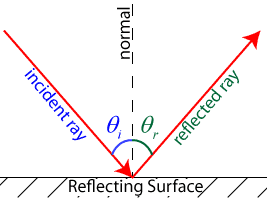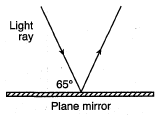Tag Archives: frequency
Reflection and Review
When a wave hits a boundary, three different events can occur. The wave may be:
- Reflected – wave bounces off a boundary
- Transmitted – wave is transmitted into the new medium
- Absorbed – energy of the wave is transferred into the boundary medium

The law of reflection states that the angle at which a wave strikes a reflective medium (the angle of incidence, or ![]() ) is equal to the angle at which a wave reflects off the medium (the angle of reflection, or
) is equal to the angle at which a wave reflects off the medium (the angle of reflection, or ![]() ). Put more simply,
). Put more simply, ![]() . In all cases, the angle of incidence and the angle of reflection are measured from a line perpendicular, or normal, to the reflecting surface.
. In all cases, the angle of incidence and the angle of reflection are measured from a line perpendicular, or normal, to the reflecting surface.
Although all waves can exhibit these behaviors, electromagnetic light waves are typically considered for demonstration purposes. When a wave bounces off a reflective surface, the nature of its reflection depends largely on the nature of the surface. Rough surfaces tend to reflect light in a variety of directions in a process known as diffuse reflection. Diffuse reflection is the type of reflection typically observed off of pieces of paper. Smooth surfaces tend to reflect light waves in a more regular fashion, such that the reflected rays maintain parallel reflected rays. This process is known as specular reflection, and is commonly observed in mirrors.
Question: The diagram represents a light ray reflecting from a plane mirror. Find the angle of reflection for the light ray.
Answer: The angle of reflection must be 25°, since the angle of incidence is 25° (note that angles are always measured from the normal!)
Review Problems
Key Points:
The velocity of a wave depends upon its medium.
The frequency of a wave determines its nature and remains constant from medium to medium.
Doppler Effect & Resonance
The shift in a wave’s observed frequency due to relative motion between the source of the wave and the observer is known as the Doppler Effect. In essence, when the source and/or observer are moving toward each other, the observer perceives a shift to a higher frequency, and when the source and/or observer are moving away from each other, the observer perceives a lower frequency.
This can be observed when a vehicle travels past you, demonstrated in the video. As you hear the vehicle approach, you can observe a higher frequency noise, and as the vehicle passes by you and then moves away, you observe a lower frequency noise.
The Doppler Effect results from waves having a fixed speed in a given medium. As waves are emitted, a moving source or observer encounters the wave fronts at a different frequency than they waves are emitted, resulting in a perceived shift in frequency. This animation may help you visualize this effect:
Question: A car’s horn is producing a sound wave having a constant frequency of 350 hertz. If the car moves toward a stationary observer at constant speed, the frequency of the car’s horn detected by this observer may be:
- 320 Hz
- 330 Hz
- 350 Hz
- 380 Hz
Answer: If source is moving toward stationary observer, observed frequency must be higher than source frequency, therefore the correct answer is (4) 380 Hz.
An exciting application of the Doppler Effect involves the analysis of radiation from distant stars and galaxies in the universe. Based on the basic elements that compose stars, we know what frequencies of radiation to look for. However, when analyzing these objects, we observe frequencies shifted toward the red end of the electromagnetic spectrum (lower frequencies), known as the Red Shift. This indicates that these celestial objects must be moving away from us. The more distant the object, the greater the red shift. Putting this together, we can conclude that more distant celestial objects are moving away from us faster, and therefore, the universe as we know it must be expanding!
Resonance
Certain devices create strong sound waves at a single specific frequency. If another object, having the same "natural frequency," is impacted by these sound waves, it may begin to vibrate at this frequency, producing more sound waves. The phenomenon where one object emitting a sound wave with a specific frequency causes another object with the same natural frequency to vibrate is known as resonance. A dramatic demonstration of resonance involves a singer breaking a glass by singing a high pitch note. The singer creates a sound wave with a frequency equal to the natural frequency of the glass, causing the glass to vibrate at its natural, or resonant, frequency so energetically that it shatters.
Question: Sound waves strike a glass and cause it to shatter. This illustrates what phenomenon?
Answer: Resonance.



















